Austrade Institute – Online Course Content Shell Template
Course Title
Austrade Social Media Module 1 – “Safe Social Media Practice”
Contact Person
Contact No.
Course Outcomes
By the end of this module you will have an understanding of:
• the definitions of
personal,
professional and
official social media usage,
• what social media is and some of the different social media platforms,
• the importance of taking safety and security online seriously, and
• Austrade's key policies and guidelines on social media use and why it is essential you understand
your responsibilities.
Instructions for Use
• Details for the name of the course and topic headings need to be written
exactly as you would like them to appear in the Module (eg: use of upper
case and lower case).
• If you have any links to documents, websites to be included throughout the course, ensure that you provide the full address of the specific
screen/page of the website.
• Include the names of the documents to be attached, in the Instructions (Graphics, Websites etc) column, and the format that you would like these
attachments to appear (eg. .pdf, text in a pop-up window etc). Use this column to indicate any ideas you may have for graphics and any other
ideas/suggestions to enhance the look and feel of the course.
• Through the course, we are able to include brief exercises. These can be in the form of: multiple choice questions, single-select questions, free text
answers and compare.
• Copy and paste the contents of page 3 for each new screen. Ctrl/Enter creates a new page.
Austrade Institute – Online Course
1/49
Austrade Institute – Online Course Content Shell Template
Topics
Topic Headings
No. of Pages
Welcome
1
Introduction
1
The different levels of social media usage
1
What is social media?
5
Using social media at work
6
Identifying and managing risk
4
Scenarios
1
Conclusion
1
Assessment
2
Results
1
Total No. of Pages
23
Austrade Institute – Online Course
2/49

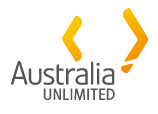 Austrade Institute – Online Course Content Shell Template
Topic Heading: Overview
Page 1 of 23
Page Content
Instructions (Graphics, websites, etc)
Austrade Social Media Module 1 - "Safe Social Media Practice"
Austrade Institute – Online Course Content Shell Template
Topic Heading: Overview
Page 1 of 23
Page Content
Instructions (Graphics, websites, etc)
Austrade Social Media Module 1 - "Safe Social Media Practice" Welcome.
This module is designed to provide you with a basic understanding of
different Social Media platforms and their uses both at home and at
work.
All Austrade staff have a responsibility to familiarise themselves with our
Social Media Policy and adhere to and follow Austrade policies and
procedures.
This course will take approximately 40 minutes to complete.
Click the Next button to continue.
Austrade Institute – Online Course
3/49
 Austrade Institute – Online Course Content Shell Template
Topic Heading: Introduction
Page 2 of 23
Page Content
Instructions (Graphics, websites, etc)
Austrade Institute – Online Course Content Shell Template
Topic Heading: Introduction
Page 2 of 23
Page Content
Instructions (Graphics, websites, etc)
Welcome to Austrade's Social Media Online Training Module No.1: "Safe
Social Media Practice".
This module has been created to help Austrade staff understand what
social media is and how it can be leveraged within the context of the
Australian Public Service.
Completion of this module
does not confer permission to run a social
Links for image:
media project on behalf of Austrade or the Australian Government.
Austrade staff wanting to use social media for
official usage must be
https://www.linkedin.com/company/australian-trade-
accredited and endorsed by their manager and the Media and
commission
Communications team in the Executive Office.
https://twitter.com/Austrade
They will also need to complete Module No.2 "Proactive Social Media
Campaigning" and complete a Social Media Employee Participation Form.
https://www.youtube.com/user/austrade
While working through this module you should read the pop-up boxes
http://www.austrade.gov.au/Site-information/RSS
linked to each page as they contain information required to answer the
'quiz' at the end.
By the end of this module you will have an understanding of:
• the definitions of
personal,
professional and
official social media
usage,
• what social media is and some of the different social media
platforms,
• the importance of taking safety and security online seriously, and
• Austrade's key policies and guidelines on social media use and why
it is essential you understand your responsibilities.
Austrade Institute – Online Course
4/49
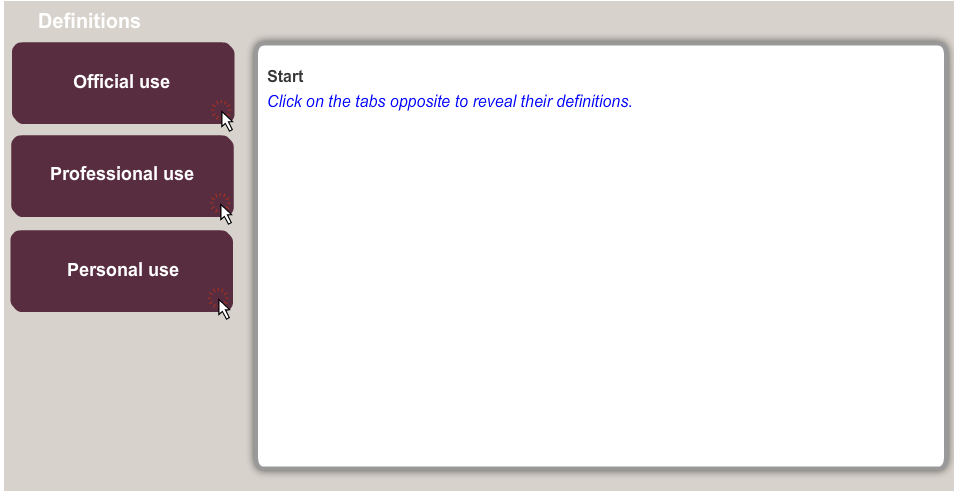 Austrade Institute – Online Course Content Shell Template
Topic Heading: The different levels of social media usage
Page 3 of 23
Page Content
Austrade Institute – Online Course Content Shell Template
Topic Heading: The different levels of social media usage
Page 3 of 23
Page Content
The use of social media by Austrade staff for personal, professional and official use is governed by the Australian Public Service
Commission
Circular 2012/1: Revisions to the Commissions Guidance on making public comment and participating online.
Instructions (Graphics, websites, etc)
Austrade Institute – Online Course
5/49
Pop-ups:
Official Use: Official use is when an Austrade employee participates/comments in social media as an official Austrade
representative. Official use constitutes comment about a market, industry, and any Austrade policy or
program.
If participating in a third-party blog, forum, page or group the spokesperson must identify themselves as an
Austrade employee, stating their name and position. Furthermore, any official use should be done using a
profile that is identified as an official Austrade account.
For example: A Senior Trade Commissioner should not make official comment from his/her personal
twitter profile/account but rather via a sanctioned Austrade twitter profile/account (eg @AustradeJakarta)
Professional Use:
Professional use is when an Austrade employee participates/comments in social media personally but as
an experienced person in a particular field. This must be done using a profile that is not identified as an
official Austrade account.
When commenting in a professional capacity an Austrader may or may not choose to identify as an
Austrade employee. If they do identify as an Austrade employee they must provide a disclaimer making it
clear that their views do not represent those of Austrade. This is an example of the kind of statement
Austraders should use when participating in social media for professional purposes.
"This site, post, or comment is for discussion purposes only and does not represent the official views of
Austrade. Any views expressed are those of the individual author only."
For example: Austrade staff using LinkedIn with the aim of expressing an opinion about a subject that
could be perceived as being within the scope of their expertise (for example, "the benefits of free trade
agreements") is classified as "Professional Use". In these instances, staff are not expressly looking to
connect with an investor, client or customer on behalf of Austrade. Rather, they may be commenting in a
business forum or a professional members group (such as a Chartered Accountant Group). In these
instances, staff should always use the disclaimer to state that their views are not necessarily the views of
Austrade.
Austrade Institute – Online Course
6/49
Personal Use: Personal use is when an Austrade employee participates/comments in social media as an individual and
not in an official capacity as an Austrade staff member. This should be done using a profile that is not
identified as an official Austrade account. In addition, Austrade staff should not identify their employer in
their personal social media profile.
For example: Austrade staff should not list Austrade as their place of work within their personal social
media profiles such as Facebook or Twitter.
It is important to be aware that comments and conduct engaged in outside of work can nevertheless have
a connection with, or reflect on, Austrade, the Commonwealth or the employee's role as an APS
employee. This may be the case even where the employee is not named or where privacy settings are
used on the social media site. Once posted, the comments may be forwarded and viewed elsewhere.
Comments made in a personal capacity on social media sites must not give rise to concerns that the
employee cannot perform their duties in an impartial and professional manner.
Austrade Institute – Online Course
7/49
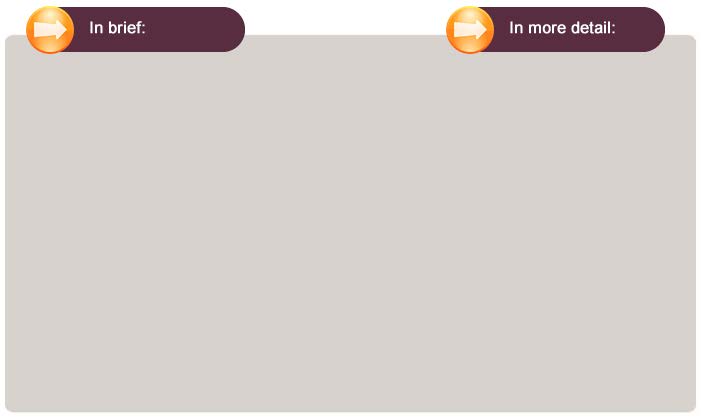 Austrade Institute – Online Course Content Shell Template
Topic Heading: What is "Social Media"?
Page 4 of 23
Page Content
Roll over each of the icons below for explanations of "Social Media".
Austrade Institute – Online Course
8/49
Austrade Institute – Online Course Content Shell Template
Topic Heading: What is "Social Media"?
Page 4 of 23
Page Content
Roll over each of the icons below for explanations of "Social Media".
Austrade Institute – Online Course
8/49
Instructions (Graphics, websites, etc)
Pop-ups:
In Brief:
Social media is defined as mobile and/or web-based technology used for interaction by which
people create, share or exchange information and ideas in virtual communities and networks.
In more detail:
Examples of social media include (but are not limited to): social and business networking services,
chat rooms, social blogs, wikis, podcasts, internet forums, online gaming sites and dating sites; and
any website that allows users to post dialogue, pictures and video, or provides access to picture-
sharing, mobile device applications, instant messaging and sites such as YouTube.
Social media is an integrated business activity which goes beyond traditional marketing.
Austrade's social media engagement aims to create business value by:
• Communicating trade and investment opportunities/insights to target audiences
• Building brand equity with target audiences (positive thoughts, feelings, beliefs, opinions and
perceptions about Australia as a trade and investment destination/partner)
• Develop brand salience with target audiences (ensure Australia is kept at the "front of mind"
of potential customers/clients)
• Develop and foster a community of engagement and value exchange
Austrade Institute – Online Course
9/49
 Austrade Institute – Online Course Content Shell Template
Topic Heading: What is "Social Media"?
Page 5 of 23
Examples of popular social media platforms
Page Content
Learn about these social media platforms by clicking on each of the icons in the graphic below.
Austrade Institute – Online Course
10/49
Austrade Institute – Online Course Content Shell Template
Topic Heading: What is "Social Media"?
Page 5 of 23
Examples of popular social media platforms
Page Content
Learn about these social media platforms by clicking on each of the icons in the graphic below.
Austrade Institute – Online Course
10/49
Austrade Institute – Online Course
11/49
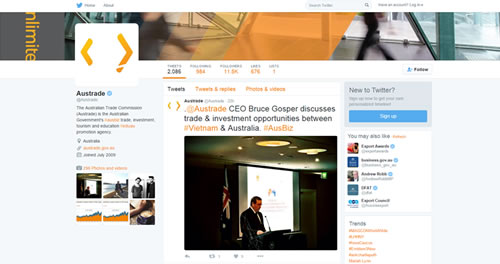 Instructions (Graphics, websites, etc)
Pop-ups:
Twitter:
Instructions (Graphics, websites, etc)
Pop-ups:
Twitter:
Twitter is a global social networking platform that allows its
users to send and read 140-character messages known as
"tweets". It enables registered users to read and post their
tweets through the web and mobile applications.
As a global real-time communications platform, Twitter has
more than 400 million monthly visitors and more than 300
million monthly active users around the world. Twitter's active
group of registered members includes World leaders, major
athletes, star performers, news organizations, and
entertainment outlets. It is currently available in more 35
languages.
Austrade Institute – Online Course
12/49
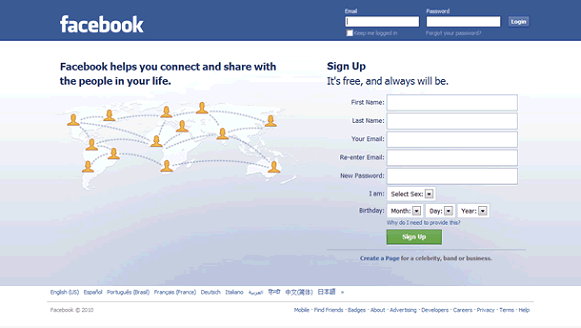 Facebook:
Facebook:
Facebook is a social networking service and website that was
launched in February 2004. In May 2012 it began trading on the
NASDAQ and in February 2016 it became the 4th most valuable
company in the world (taking Exxon's place).
Facebook allows users to create a personal profile, upload photos
and videos, add other users as friends and exchange messages,
including automatic notifications when they update their profile.
Users can also create and join interest groups and "like pages",
some of which are maintained by organisations as a means of
advertising.
Facebook enables users to choose their own privacy settings and
choose who can see specific parts of their profile. Facebook has
more than 1 billion daily active users.
Austrade Institute – Online Course
13/49
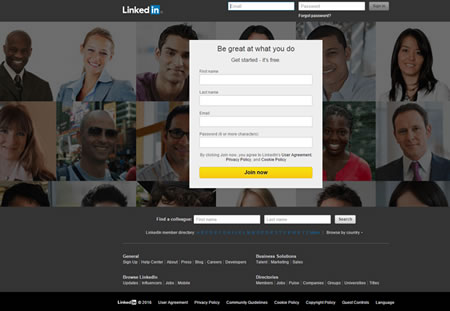 LinkedIn:
LinkedIn:
LinkedIn is the world's largest professional network with more than
400 million members in 200 countries and territories around the
globe.
When users join LinkedIn, they can get access to people, jobs,
news, updates, and insights that help them in their job and career
development.
LinkedIn allows registered users to maintain a list of contact details
of people they know and trust in business.
On LinkedIn users can follow different companies and can get
notifications about the new vacancies and offers available.
LinkedIn also has a feature called "Groups". LinkedIn Groups
provide a place for professionals in the same industry or with
similar interests to share content, find answers, post and view jobs,
make business contacts, and establish themselves as industry
expert.
Austrade Institute – Online Course
14/49
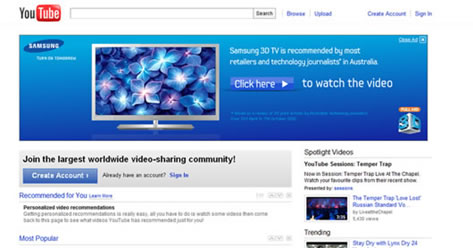 YouTube:
YouTube:
Launched in May 2005, YouTube allows billions of people to
discover, watch and share originally-created videos.
YouTube provides a forum for people to connect, inform,
and inspire others across the globe and acts as a
distribution platform for original content creators and
advertisers large and small.
YouTube is a Google company.
Only registered users may upload videos but any
unregistered user can view them (although videos that are
considered to contain potentially offensive content are
available only to registered users 18 and older).
Austrade Institute – Online Course
15/49
 Austrade Institute – Online Course Content Shell Template
Topic Heading: What is "Social Media"?
Page 6 of 23
The Impact of Mobile Technology on Social Media
Page Content
Austrade Institute – Online Course Content Shell Template
Topic Heading: What is "Social Media"?
Page 6 of 23
The Impact of Mobile Technology on Social Media
Page Content
More than one-third of global internet traffic is via a mobile device.
By 2020 it is predicted that 90 percent of the world's population over 6 years old will have a mobile phone and smartphone
subscriptions are expected to top 6.1 billion.
The migration from desktop-based social media platforms to mobile-based instant messaging has had a profound impact on the
way that people communicate.
Learn about these mobile-driven social media platforms by clicking on each of the icons in the graphic below.
Austrade Institute – Online Course
16/49
Instructions (Graphics, websites, etc)
Pop-ups:
WhatsApp WhatsApp is a cross-platform mobile messaging service that allows users to send messages
without having to pay for SMS. It can be used to send text messages, video, images and audio
media messages.
In February 2016 WhatsApp reached 1 billion active users.
Facebook Messenger Facebook Messenger is an instant messaging service and software application which provides
text and voice communication. It is integrated with Facebook's web-based Chat feature.
Messenger lets Facebook users chat with friends both on mobile and on the main website.
WeChat
WeChat is a Chinese instant messaging service.
Known in Chinese as Weixin (微信) — "micro letter" — WeChat is first and foremost a
messaging app for sending text, voice, and photos to friends and family.
WeChat is basically China's version of Facebook – but it does much more than just send
messages.
WeChat users in China can access services to hail a taxi, order food delivery, buy movie
tickets, play casual games, check in for a flight, send money to friends, access fitness tracker
data, book a doctor appointment, get banking statements, pay the water bill, find geo-targeted
coupons, recognise music, search for a book at the local library, meet strangers around you,
follow celebrity news, read magazine articles, and even donate to charity … all in a single,
integrated app.
Austrade Institute – Online Course
17/49
WeChat is available to use outside of China, however, many of the most interesting features
are not visible to users outside China.
Instagram Instagram is an online mobile photo-sharing, video-sharing and social networking service that
enables its users to take pictures and videos, and share them either publicly or privately on the
app, as well as through a variety of other social networking platforms, including Facebook,
Twitter and Tumblr. Instagram offers a variety of customisable digital filters for users to apply
to their images. Instagram also incorporates a messaging feature.
KakaoTalk KakaoTalk is a mobile instant messaging service for smartphones. It is South Korea's number
one mobile-messaging service, with 93 percent of domestic smartphone users (or nearly 75
percent of the country's 50 million people) using it. In addition to free calls and messages,
KakaoTalk users can share diverse content and information including photos, videos, voice
messages, location, URL links as well as contact information. Both one-on-one and group
chats are available.
Line Line is a Japan-based mobile instant messaging service for smartphones. It is popular in
markets throughout the Asia Pacific. Thailand, Japan, Taiwan and Indonesia represent over 65
percent of Line's active users.
Austrade Institute – Online Course
18/49
 Austrade Institute – Online Course Content Shell Template
Topic Heading: What is "Social Media"?
Page 7 of 23
What do I need to know about using Social
Austrade Institute – Online Course Content Shell Template
Topic Heading: What is "Social Media"?
Page 7 of 23
What do I need to know about using Social
Media?
Page Content
All Austrade staff using social media for personal reasons (i.e. have a Facebook
profile to share news and photos with family and friends) must be mindful that as
they are public servants there is an expectation regarding how they present
themselves online relating to content and conduct. For more information see
http://www.apsc.gov.au/publications-and-media/current-circulars-and-
advices/2012/circular-20121. Austrade staff should also familiarise themselves with Section 6 of the Australian
Public Service Values and Code of Conduct, specifically Section 6,
"Employees
as citizens". The APS and Austrade's Values and Code of Conduct provides direction on
what public servants should do if there is a potential conflict of interest between
their personal and professional interests. Amongst others, such overlap may be
in the political and financial realms. The APS Values and Code of Conduct states
that there will be occasion where the public servant role will need to take priority
over the public servant's personal interest. This general principle applies to
accredited Austrade social media publishers who use social media for Official
use. For further explanation and scenarios see
http://www.apsc.gov.au/publications-and-media/current-publications/in-whose-interest Click on the arrow below for further information on privacy settings.
Austrade Institute – Online Course
19/49
 Austrade Institute – Online Course
20/49
Austrade Institute – Online Course
20/49
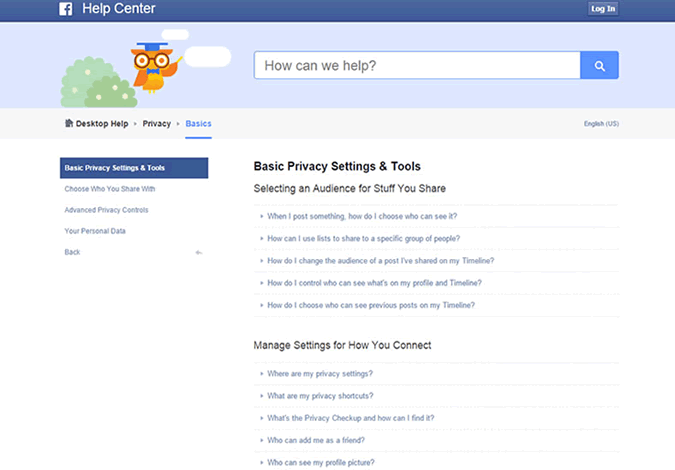 Instructions (Graphics, websites, etc)
Pop-up:
Instructions (Graphics, websites, etc)
Pop-up:
Check your
account and privacy settings on the social media you use - make sure you know who can access any posts you
publish before you post them.
You should also check that you are not revealing more personal information about yourself than is necessary.
Austrade Institute – Online Course
21/49

 Austrade Institute – Online Course Content Shell Template
Topic Heading: What is "Social Media"?
Page 8 of 23
Social Media and risk - what to be aware of
Page Content
Austrade Institute – Online Course Content Shell Template
Topic Heading: What is "Social Media"?
Page 8 of 23
Social Media and risk - what to be aware of
Page Content
For some, social media is merely an informal means of keeping in touch with friends and loved ones with no work relevance. However,
social media is also used by Australian public servants and indeed trade officials to great effect as a formal communications channel with
national 'business value'.
Social media represents a cost effective way for Austrade staff to research trading opportunities by region and sector. But where it is used
to engage in dialogue or to exchange views (instead of merely collecting intelligence), as in all our external communications you must
remain mindful of Austrade's strategic goals, key messages and potential legal liability.
Click on the arrows below for further information.
Austrade Institute – Online Course
22/49
Austrade Institute – Online Course
23/49
Instructions (Graphics, websites, etc)
Pop-ups for arrows:
What should you feel free to do in social media?
Whatever personal information you post openly on the internet, in your own time, is of no real interest to Austrade, providing it:
1)
does not reveal commercially or strategically sensitive material;
2)
only divulges information already in the public domain;
3)
is not abusive or insulting to other people, cultures or countries;
4)
will not put any Australian official or their family in danger abroad; and
5)
does not reflect poorly on your personal judgement.
What consequences can careless social media engagement have?
Use your common sense.
Posting personal, work related, or offensive material on social media can put at risk:
1)
your personal safety or that of your family;
2)
your colleagues' personal safety;
3)
Austrade's corporate brand reputation;
4)
Australia's trade position and international competitiveness; and
5)
Australia's international reputation.
Pop-up for note icon:
Remember: The same discipline that Austrade staff should feel in drafting external correspondence, or engaging mainstream television, radio or print
media should be felt when engaging social media. When in doubt, don't post!
Austrade does not wish to unduly restrict your ability to communicate with friends and family online, so this module should be read as
'enabler guidelines', as much as they represent a formal guidance to restrict inappropriate workplace behaviour.
Austrade Institute – Online Course
24/49
 Austrade Institute – Online Course Content Shell Template
Topic Heading: Using social media at work
Page 9 of 23
Examples of Workplace Social Media Issues
Page Content
Instructions (Graphics, websites, etc)
Austrade Institute – Online Course Content Shell Template
Topic Heading: Using social media at work
Page 9 of 23
Examples of Workplace Social Media Issues
Page Content
Instructions (Graphics, websites, etc)
The law surrounding social media and appropriate workplace usage is rapidly evolving. After all, Facebook has only been in existence to
the public since 2004. That said, laws governing appropriate workplace behaviour are not new, and Austrade staff should generally not
communicate anything in social media that they would not in person.
The scenarios and examples below highlight the very 'public' nature of social media, and the risks social media can pose for the individual
and the organisation.
They also reinforce the need for Austrade staff to always exercise common sense and caution when participating in social media.
Click on each of the arrows below for some recent examples of how social media usage can create difficulty in the workplace.
Austrade Institute – Online Course
25/49
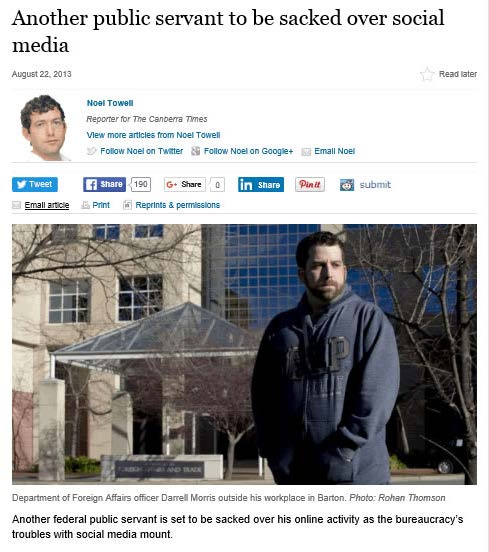 Instructions (Graphics, websites, etc)
Pop-ups for arrows:
Click on the image to read the full article online.
Austrade Institute – Online Course
26/49
Instructions (Graphics, websites, etc)
Pop-ups for arrows:
Click on the image to read the full article online.
Austrade Institute – Online Course
26/49
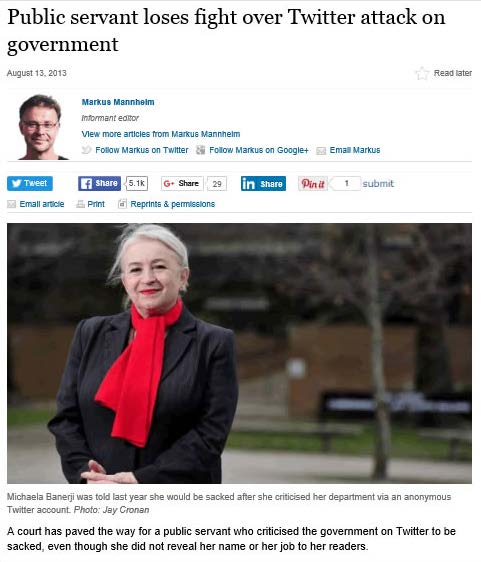 Click on the image to read the full article online.
Austrade Institute – Online Course
27/49
Click on the image to read the full article online.
Austrade Institute – Online Course
27/49
 Austrade Institute – Online Course Content Shell Template
Topic Heading: Using social media at work
Page 10 of 23
Do I need official endorsement for my Social Media usage?
Page Content
Austrade Institute – Online Course Content Shell Template
Topic Heading: Using social media at work
Page 10 of 23
Do I need official endorsement for my Social Media usage?
Page Content
You do not need Austrade endorsement to create a social media account for
personal or
professional use. However for
official use,
where you discuss trade-related matters or Austrade programs or policies, you must be accredited as an Austrade Social Media
Publisher and you must self-identify as an Austrade employee.
Where employees 'self-identify' as Austrade employees, Austrade expects them to use their common sense to safeguard their and
the organisation's reputation. The APS values and code of conduct states that there will be occasion where the public servant role will
need to take priority over the public servant's personal interest. This general principle applies to accredited Austrade social media
publishers who use social media for Official use. For further explanation and scenarios see the following links:
Instructions (Graphics, websites, etc)
Austrade Institute – Online Course
28/49
Links:
http://www.apsc.gov.au/publications-and-media/current-publications/values-and-conduct/managing-information
http://www.apsc.gov.au/publications-and-media/current-publications/aps-values-and-code-of-conduct-in-practice/employees-as-
citizens
Austrade Institute – Online Course
29/49
 Austrade Institute – Online Course Content Shell Template
Topic Heading: Using social media at work
Page 11 of 23
Official Austrade Social Media Publishers
Page Content
Austrade Institute – Online Course Content Shell Template
Topic Heading: Using social media at work
Page 11 of 23
Official Austrade Social Media Publishers
Page Content
If you intend to act as an official Austrade Social Media Publisher or to create an official Austrade social media presence (page or
group within a social media site), for example "the Australian Lamb Exporters Group" in LinkedIn, you will need to be accredited.
Accreditation requires authorisation from your line manager and endorsement from the Social Media Adviser. Social Media Module 2
explains further what is required to gain accreditation.
Any content (words, images, videos, etc) within any
official social media page is read by the public as official communication by
Austrade, and as such the content must be:
Click on the arrows above to reveal the text.
Instructions (Graphics, websites, etc)
Pop-ups for arrows:
'on message', in line with our strategic goals (as outlined for example in our corporate plan);
in keeping with Austrade's corporate style and branding (appropriate logo and crest);
Austrade Institute – Online Course
30/49
designed to avoid legal liability, (use of disclaimers, and appropriately vetted by relevant managers, the and Legal); and
supportive of other communications tools (for example should drive traffic t
o www.austrade.gov.au or other official sites).
Austrade Institute – Online Course
31/49
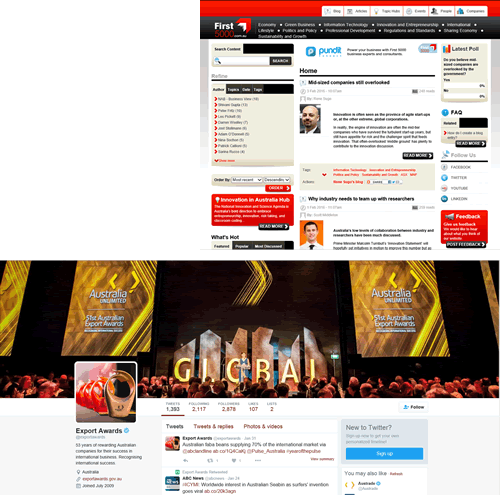 Austrade Institute – Online Course Content Shell Template
Topic Heading: Using social media at work
Page 12 of 23
Listening in Social Media
Page Content
Instructions (Graphics, websites, etc)
Austrade Institute – Online Course Content Shell Template
Topic Heading: Using social media at work
Page 12 of 23
Listening in Social Media
Page Content
Instructions (Graphics, websites, etc)
Joining groups, browsing online forums and reading blog posts
contributed by users is an effective way for Austrade staff to be
informed of the important issues and concerns being discussed
online relating to industry sectors, markets, and policies. In this
way social media can be used as a research tool in support of
our work, and is something for which no accreditation is
required.
Places such as Twitter, Facebook, LinkedIn and blogs can be
windows into how clients, customers, students and investors
think. Austrade employees can find value in social media by
following what is being said about their market, industry, and
issue.
Austrade Institute – Online Course
32/49
 Austrade Institute – Online Course Content Shell Template
Austrade Institute – Online Course Content Shell Template
Topic Heading: Using social media at work
Page 13 of 23
Using Austrade Material on Social Media
Page Content
Instructions (websites)
Links:
Please consider Austrade's obligations regarding the copyright of content (words, images, photos,
https://www.austrade.gov.au
representations) within social media. If Austrade is not the owner of the content check the terms and
/ibrand/ibrand-home.html
conditions with the owner of the content copyright (individuals, events publications, web-sites) and if
necessary obtain appropriate copyright permissions before publishing. In addition, all content, quotes and
mailto:Marketing-Comms-
excerpts should be attributed to the source, and where possible hyperlinks should be used instead of
xxxxxxxx@xxxxxxxx.xxx.xx
reproducing others' content.
All Austrade images and photos should be sourced fr
om i-brand.
Contact th
e Marketing-Comms Helpline for copyright queries on the use of Austrade material.
Copyright is an important consideration for Austrade employees using social media. Material posted on some
social media sites grants copyright permission to the social media platform.
Ordinarily, the "terms and conditions" page of social media sites explain the obligations and rights of users
with respect to copyright.
By posting photographs, music, video footage or written material on Facebook, for example, the poster grants
Facebook usage of this material.
You should therefore consider Austrade's intellectual property rights – and that of other copyright holders –
before engaging social media.
If using others' material:
• seek permission to use material where appropriate to do so
• ensure you attribute the source/author, and
• link to rather than reproduce where possible.
Austrade Institute – Online Course
33/49
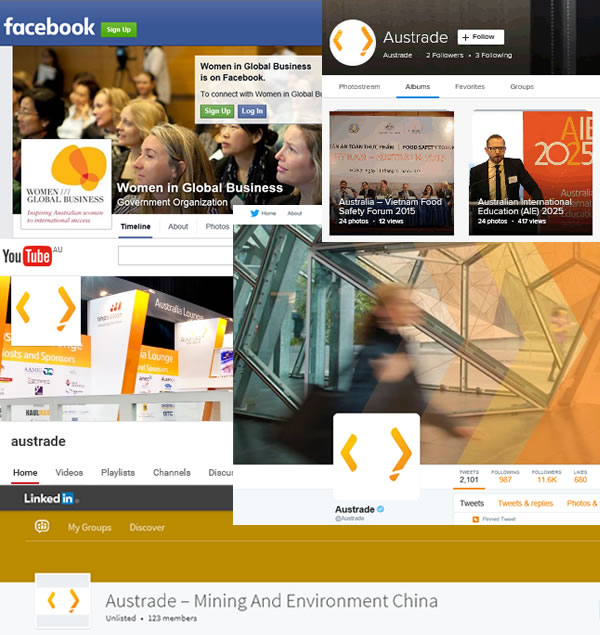 Austrade Institute – Online Course Content Shell Template
Topic Heading: Using social media at work
Page 14 of 23
Will I be monitored?
Page Content
Instructions (Graphics, websites, etc)
Austrade Institute – Online Course Content Shell Template
Topic Heading: Using social media at work
Page 14 of 23
Will I be monitored?
Page Content
Instructions (Graphics, websites, etc)
Yes everyone using social media platforms can be monitored in a
variety of ways by a large number of individuals and organisations.
This can include local, national and international media.
Journalists are increasingly monitoring platforms like Facebook and
Twitter as a means of finding news stories. As a rule, do not post
anything online that you would not feel comfortable reading on the
front page of The Sydney Morning Herald.
"In the Hunt for Sources, it seems pretty clear that outlets like
CNN are bent on using Twitter for its more sensational aspects,
but in a practical sense it is useful, and will continue to be used,
as a jump-off point for further investigating into up-to-the-minute
reporting."
Source:
www.socialmediatoday.com 4 June 2010
In this context, Austrade is also monitoring social media to protect
our corporate brand, and to identify opportunities to advance
Australia's trade and investment interests.
Austrade Institute – Online Course
34/49
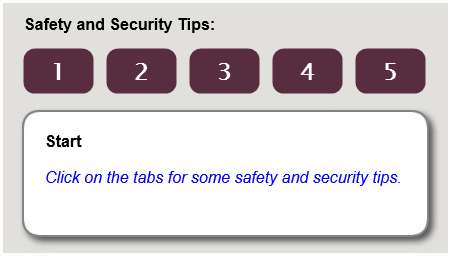
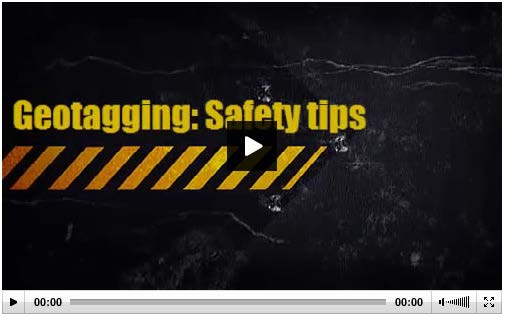 Austrade Institute – Online Course Content Shell Template
Topic Heading: Identifying and Managing Risk
Page 15 of 23
What not to reveal on social media
Page Content
Should I divulge travel information?
Austrade Institute – Online Course Content Shell Template
Topic Heading: Identifying and Managing Risk
Page 15 of 23
What not to reveal on social media
Page Content
Should I divulge travel information?
Austrade strongly advises that travel information should not be posted
on social media. Even apparently innocuous information could
potentially put Australian bureaucrats or their families at risk.
Social media applications that provide information about travel plans and
geo-tagging applications that indicate users' actual whereabouts must
not be used for Austrade staff work travel or within Austrade social
media presences. Examples include Trip-it and Foursquare. It is also
recommended that these tools not be used for staff personal travel as
well.
Austrade Institute – Online Course
35/49
 In structions (Graphics, websites, etc)
Pop-ups:
In structions (Graphics, websites, etc)
Pop-ups:
Social media privacy settings should be set at Maximum. (Default settings are not enough).
Do not list your home address or mobile telephone number.
Do not post anything online that might expose you to blackmail.
Do not share personal financial information unless through a secure payment method.
When uploading photos, make sure you use your common sense.
Video:
Geotagging_safety_
tips-v3.mp4
double click to view video
Austrade Institute – Online Course
36/49
 Austrade Institute – Online Course Content Shell Template
Topic Heading: Identifying and Managing Risk
Page 16 of 23
What not to reveal on social media
Page Content
Austrade Institute – Online Course Content Shell Template
Topic Heading: Identifying and Managing Risk
Page 16 of 23
What not to reveal on social media
Page Content
Information that is "commercial in confidence or strategically sensitive" should not be divulged within a social media site.
Remember this information could relate to internal Austrade information as well as information about our clients, customers and
investors.
Some examples include:
Click on the arrows.
Austrade Institute – Online Course
37/49
Instructions (Graphics, websites, etc)
Pop-ups for arrows:
Internal Austrade strategic planning decisions.
A client's intention to export to a particular country.
A client's sale overseas that has not been publicly announced.
An inwards investment success that has not been publicly announced.
Austrade Institute – Online Course
38/49
 Austrade Institute – Online Course Content Shell Template
Topic Heading: Identifying and Managing Risk
Page 17 of 23
Key policies and guidelines
Page Content
Instructions (Graphics, websites, etc)
Austrade Institute – Online Course Content Shell Template
Topic Heading: Identifying and Managing Risk
Page 17 of 23
Key policies and guidelines
Page Content
Instructions (Graphics, websites, etc)
Take a moment to get to know key policies.
Click on the tabs below.
Links for tabs:
http://thehub/ws/ao/bs/Documents/1.%20Business%20Practice
%20Guides/Austrade%20Service%20Handbook%20Media%2
0Policy.pdf
http://thehub/Policy/Pages/Social-Media-Policy.aspx
Austrade Institute – Online Course
39/49
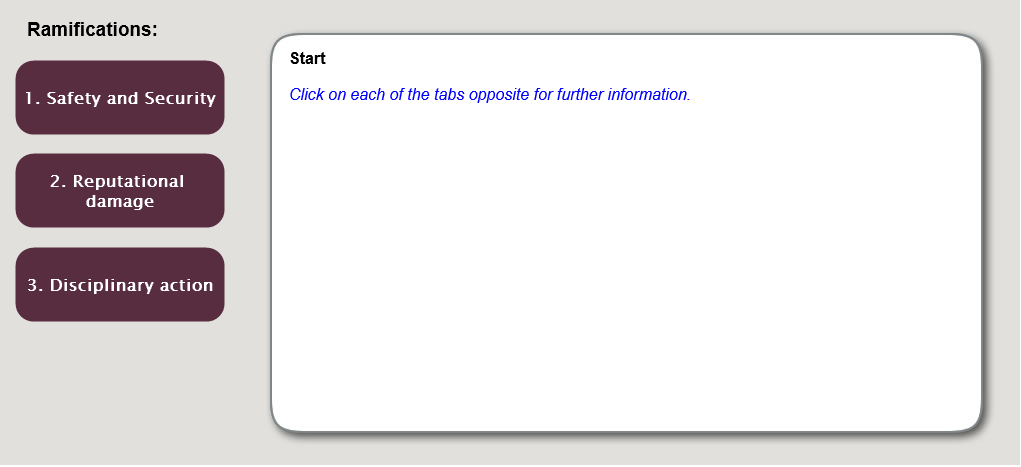 Austrade Institute – Online Course Content Shell Template
Austrade Institute – Online Course Content Shell Template
Topic Heading: Identifying and Managing Risk
Page 18 of 23
What are the ramifications if I ignore these policies?
Page Content
Austrade Institute – Online Course
40/49
Instructions (Graphics, websites, etc)
Pop-ups:
Safety and Security The safety and security of Austrade employees is our utmost concern. You may become subject to kidnapping or attack abroad
if you reveal your travel plans, or you may fall victim to stalking or identity theft at home if you are careless in your online
communications or relaxed in your privacy settings.
Reputational damage: Once information is published online it is a permanent record. We encourage the use of social media, however, care and
responsibility must be taken to ensure that no damage or problems arise. Social media has the potential to cause an individual
reputational damage and significant damage to the Austrade brand.
Disciplinary action: Failure to comply with Austrade policies, including those relating to social media, may result in disciplinary action under the
APS Code of Conduct (A-based employees) or the OEE Code of Conduct (Overseas Engaged Employees). The
consequences of a finding of misconduct include a reprimand, demotion and in the most serious cases, dismissal. If you are
not sure whether you are complying with relevant policies, seek your manager's advice before placing information online.
Austrade Institute – Online Course
41/49
 Austrade Institute – Online Course Content Shell Template
Topic Heading: FAQs and Scenarios
Page 19 of 23
Scenarios
Page Content
Click on each of the boxes to reveal the answers to these scenarios.
Austrade Institute – Online Course
42/49
Austrade Institute – Online Course Content Shell Template
Topic Heading: FAQs and Scenarios
Page 19 of 23
Scenarios
Page Content
Click on each of the boxes to reveal the answers to these scenarios.
Austrade Institute – Online Course
42/49
Instructions (Graphics, websites, etc)
Pop-ups:
Scenario 1:
Given the potential for those photos to identify Austrade or Embassy staff and potentially compromise or embarrass those staff, it
is recommended that party photos that include Austrade or Embassy staff not be published on personal blogs.
Scenario 2:
Household members of APS employees serving overseas are not covered directly by the Code of Conduct for Overseas Service,
nor are they subject to any Austrade directions in relation to conduct. However, the high visibility of household members as part
of an Australian official community means you and your partner need to exercise judgment and caution about the material on
your partner's blog. Even where there is no material on the blog which could be construed as official information, indiscreet
comments about prominent citizens in your host country could damage the reputation of Austrade, the embassy and Australia. In
accordance with the Code of Conduct for Overseas Service you must take all reasonable steps to ensure that your partner's blog
does not inadvertently damage the reputation of Austrade, the Embassy and Australia.
Scenario 3:
For security reasons Austrade staff should not divulge travel arrangements or whereabouts using social media applications. It is
also recommended that these tools not be used for staff personal travel.
Austrade Institute – Online Course
43/49

 Austrade Institute – Online Course Content Shell Template
Topic Heading: Conclusion
Page 20 of 23
Page Content
Austrade Institute – Online Course Content Shell Template
Topic Heading: Conclusion
Page 20 of 23
Page Content
Congratulations! You have completed the
Austrade Social Media Module 1 "Safe Social Media Practice" online course.
Now it's time to test your knowledge with a short assessment about the information in this course. This is an important element of
Austrade's commitment to providing you with the tools to understand social media, as well as the APS and Austrade guidelines
and policies.
Before you can start the assessment you need to have worked your way through the course. To successfully complete the
assessment you must achieve a
100% pass mark.
If you don't answer all questions in the assessment correctly the first time, you may attempt them again. The questions that you
answered correctly will hold their answers.
You will only need to answer the questions that were incorrect.
When you attempt the assessment please read each question carefully and select the correct answer/s by clicking the
appropriate button/s. Once you have completed the assessment click 'Done' to submit your answers.
When you are ready to attempt the final assessment click next page.
Austrade Institute – Online Course
44/49
 Austrade Institute – Online Course
45/49
Austrade Institute – Online Course
45/49
Austrade Institute – Online Course Content Shell Template
Topic Heading: Assessment
Page 21 of 23
Page Content
Q1. Completion of Module 1 "Safe Social Media Practice" enables Austrade employees to create social media sites on behalf of
Austrade.
• True
• False
Q2. Any Austrade employee is empowered to act as an organisation spokesperson in social media.
• True
• False
Q3. I do not need Austrade approval to create a personal Facebook presence.
• True
• False
Q4. I should amend the default privacy settings in social media to prevent unrestricted public access to my posts.
• True
• False
Austrade Institute – Online Course
46/49
Topic Heading: Assessment
Page 22 of 23
Page Content
Q5. It is ok to list Austrade as my employer in my personal Facebook profile.
• True
• False
Q6. Austrade employees can blog on trade issues without authorisation, provided it is done anonymously.
• True
• False
Q7. Austrade's social media modules 1 and 2 supersede Austrade's IT security policy.
• True
• False
Q9. Austrade staff who are not accredited social media publishers must still be mindful that their online participation does not
cause a conflict of interest with their public servant role and does not inadvertently damage the reputation of Austrade, the
Australian government, and Australia.
• True
• False
Austrade Institute – Online Course
47/49
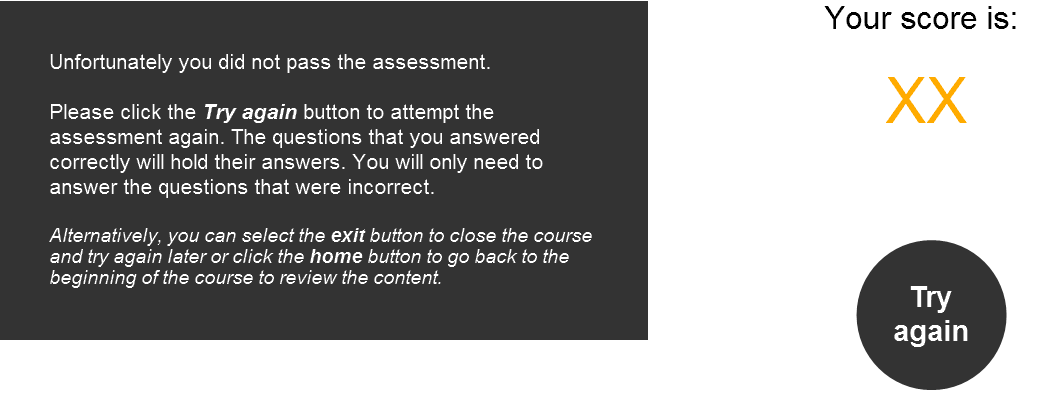 Topic Heading: Results
Page 23 of 23
Page Content
Topic Heading: Results
Page 23 of 23
Page Content
Or
Austrade Institute – Online Course
48/49
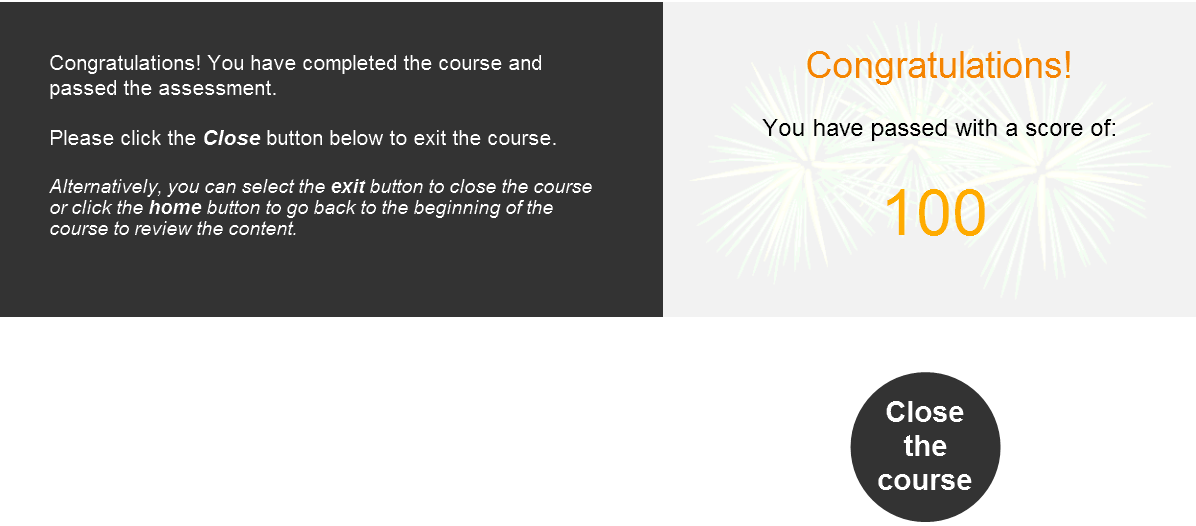 Austrade Institute – Online Course
49/49
Austrade Institute – Online Course
49/49
Document Outline



































